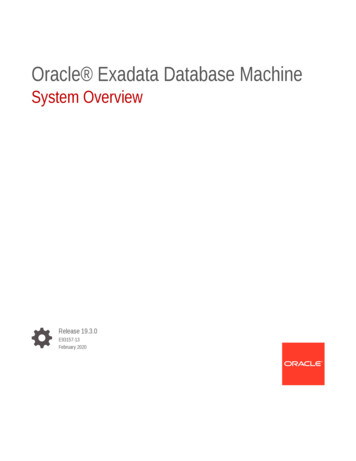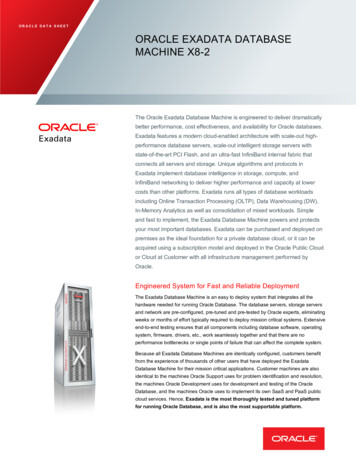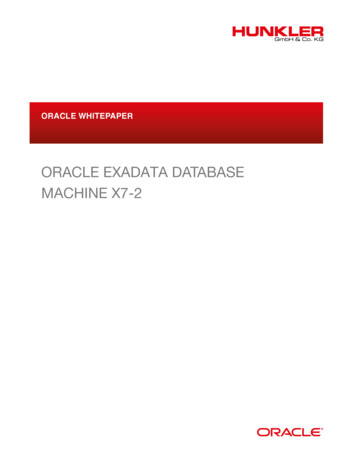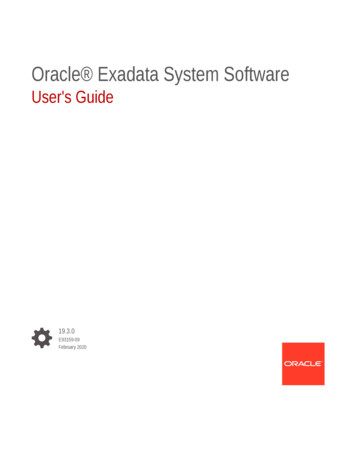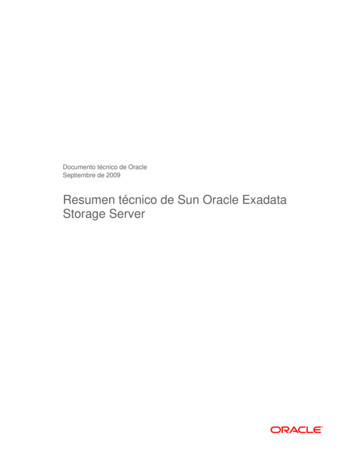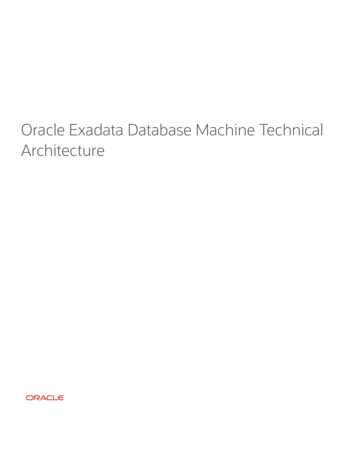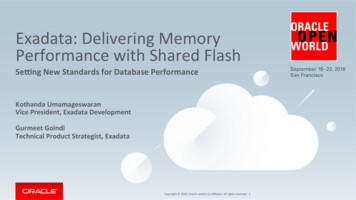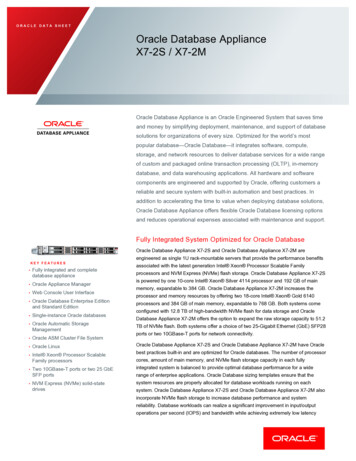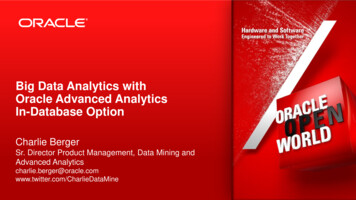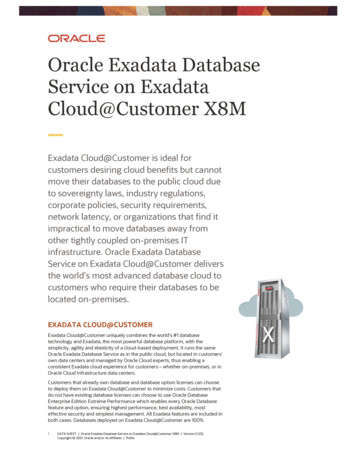
Transcription
Oracle Exadata DatabaseService on ExadataCloud@Customer X8MExadata Cloud@Customer is ideal forcustomers desiring cloud benefits but cannotmove their databases to the public cloud dueto sovereignty laws, industry regulations,corporate policies, security requirements,network latency, or organizations that find itimpractical to move databases away fromother tightly coupled on-premises ITinfrastructure. Oracle Exadata DatabaseService on Exadata Cloud@Customer deliversthe world’s most advanced database cloud tocustomers who require their databases to belocated on-premises.EXADATA CLOUD@CUSTOMERExadata Cloud@Customer uniquely combines the world’s #1 databasetechnology and Exadata, the most powerful database platform, with thesimplicity, agility and elasticity of a cloud-based deployment. It runs the sameOracle Exadata Database Service as in the public cloud, but located in customers’own data centers and managed by Oracle Cloud experts, thus enabling aconsistent Exadata cloud experience for customers – whether on-premises, or inOracle Cloud Infrastructure data centers.Customers that already own database and database option licenses can chooseto deploy them on Exadata Cloud@Customer to minimize costs. Customers thatdo not have existing database licenses can choose to use Oracle DatabaseEnterprise Edition Extreme Performance which enables every Oracle Databasefeature and option, ensuring highest performance, best availability, mosteffective security and simplest management. All Exadata features are included inboth cases. Databases deployed on Exadata Cloud@Customer are 100%1DATA SHEET Oracle Exadata Database Service on Exadata Cloud@Customer X8M Version [1.05]Copyright 2021, Oracle and/or its affiliates Public
compatible with both existing on-premises databases and databases that aredeployed in Oracle Cloud Infrastructure.WHAT’S NEW IN EXADATA CLOUD@CUSTOMERX8MExadata Cloud@Customer X8M brings Exadata X8M hardware, a superiornetwork fabric and improved virtualization to Exadata Cloud@Customer. ExadataX8M storage servers include persistent memory, creating an additional tier ofstorage, boosting overall system performance. Exadata X8M combines persistentmemory with innovative RDMA algorithms that bypass the network and I/Ostack, eliminating expensive CPU interrupts and context switches, reducinglatency by 10x, from 200µs to less than 19µs.Exadata Cloud@Customer X8M has a new faster 100Gbps Remote DirectMemory Access over Converged Ethernet (RoCE) internal network fabric,providing 2.5x more bandwidth than previous generations and an extremely lowlatency interconnect between all compute and storage servers. The new platformalso enables denser consolidation of databases, upgrading the hypervisor toKernel Virtual Machine (KVM) and increasing the available memory to 1390GBper physical server for quarter rack and larger configurations.Key Features Easy and rapid databaseprovisioning in a few clicksCloud automation softwarereduces administrationSubscribe to only the computecores needed by the applicationScale up and down as needed100% compatibility with onpremises and Oracle CloudInfrastructure databasesComprehensive databasemanagement through OracleEnterprise Manager, as well asCloud-based self-serviceautomationExadata infrastructuremanagement and monitoring byOracle Cloud OperationsKey Business BenefitsTHE BEST DATABASE ON THE BEST CLOUDPLATFORMOracle Exadata has been the best database platform for over 10 years. Similarly,Oracle Exadata in the cloud is the best cloud database platform, as it can deliverextreme performance, mission critical availability and the highest security for allOnline Transaction Processing (OLTP), Data Warehousing (DW), In-MemoryAnalytics, and Mixed/Hybrid workloads, making it the ideal databaseconsolidation platform for the cloud.Best Database TechnologyOracle Database is the most popular and most versatile database technology forboth OLTP and Analytics. With decades of technology innovation, it has beenproven at hundreds of thousands of mission-critical deployments around theworld. Exadata Cloud@Customer makes this enterprise-proven, robust databasetechnology available in a cloud-based consumption model at customers’ datacenters behind their firewalls.Most Powerful Database Infrastructure and PlatformThe platform that delivers Exadata Cloud is Oracle Exadata, which has beenestablished as the highest performing, most cost effective and highest availableplatform for deploying Oracle databases. Exadata was designed from thebeginning as a cloud architecture featuring scale-out database servers and scaleout intelligent storage servers. With X8M, they are now connected by a fasterRoCE network. Exadata delivers many smart hardware and software innovationsfor databases, distinguishing itself from other generic converged systems.Cloud Automation and Subscription ModelOn top of the rock-solid Oracle Database and Exadata platform, ExadataCloud@Customer adds the ease, simplicity, and flexibility of the software thatpowers Oracle Cloud Infrastructure. Organizations can now access the OracleDatabase on Oracle Exadata with a simple consumption/subscription model intheir own data center behind their firewall. Oracle experts manage the Exadata2DATA SHEET Oracle Exadata Database Service on Exadata Cloud@Customer X8M Version [1.05]Copyright 2021, Oracle and/or its affiliates Public Cloud simplicity with onpremises deploymentFaster time-to-market with webbased database provisioningSubscription-based pricing, withability to bring your own licenses(BYOL) to cloudScale up and down as neededand pay only what you useEasily migrate existingdatabases with no applicationchangesReduced IT administrationFast local RoCE networkconnectivity delivers betterresponse times than PublicCloudsOn-premises deployment tomeet compliance and datasovereignty requirementsProven mission-critical databaseand platformExtreme performance for OLTP,Analytics, Hybrid, andConsolidation workloadsFocus staff on improvingbusiness, not operatinginfrastructure
infrastructure on behalf of customers, which means human resources and ITadministration costs are significantly reduced, and IT can focus on improvingbusiness results. Full Oracle Database functionality with ExadataCloud@Customer ensures that any existing application can be quickly migratedto a cloud model without changes. Provisioning and expanding the databaseservice deployed on the Exadata Cloud@Customer is driven through simple webinterfaces, providing customers rapid elasticity to meet changing businessdemands.EXADATA: THE BEST DATABASE PLATFORMExadata HardwareExadata Cloud@Customer comes in different infrastructure shapes to supportworkloads of different sizes. The Exadata Cloud@Customer Base Systemprovides a cost-effective Exadata entry point, while traditional quarter, half, andfull rack shapes can meet nearly any CPU processing and database storagerequirements. Online dynamic scaling of OCPU resources is available in everyExadata Cloud@Customer shape so that customers can pay only for the OCPUsthat they use, dramatically reducing costs compared to a traditionally purchasedplatform. Exadata Cloud@Customer also supports online storage serverexpansion up to a total of twelve storage servers, allowing customers to addstorage independently from compute.All the Exadata Cloud@Customer shapes are built on powerful database servers,scale-out intelligent storage servers, PCI NVMe flash, and high capacity diskdrives. Internal connectivity between database and storage servers is enabled bya low-latency RoCE fabric. External connectivity to the Exadata Cloud@Customersystem is provided using standard 10 or 25 Gigabit Ethernet.Related Products Oracle Autonomous DatabaseOracle Exadata Cloud ServiceOracle Exadata Database MachineOracle Database 12c and 19cReal Application ClustersPartitioningMultitenantDatabase In-MemoryAdvanced CompressionAdvanced SecurityActive Data GuardReal Application TestingAdvanced AnalyticsEnterprise ManagerOracle LinuxThe database-optimized data tiering between RAM, PMEM, flash and diskimplemented in Exadata provides lower latency, higher capacity, and fasterperformance than other flash- or PMEM-based solutions. Flash and PMEMstorage arrays cannot match the throughput of Exadata's integrated andoptimized architecture with full RoCE-based scale-out, high speed persistentmemory, PCI NVMe flash, offload of data intensive operations to storage, andalgorithms that are specifically optimized for databases.Exadata SoftwareThe technology that enables Exadata’s unparalleled performance without any of the bottlenecks of traditional storagearrays is Exadata Storage Server software. This software powers the Exadata storage servers, providing an extremelyefficient and database-optimized storage infrastructure. All Exadata Storage Server software features are included inExadata Cloud@Customer.One of the many unique features of Exadata Storage Server software is Smart Scan technology, which offloads dataintensive SQL operations from the database servers directly into the storage servers. By pushing SQL processing to thestorage servers, data filtering and processing occur immediately and in parallel across all storage servers, as data is readfrom disk and flash. Only the rows and columns that are directly relevant to a query are sent to the database servers.This greatly accelerates analytic queries, eliminates bottlenecks, and significantly reduces the CPU usage of thedatabase servers.In addition to Smart Scan, Exadata includes a vast array of software capabilities that enables its unparalleled scalability,performance and availability. Some of these Exadata software features are: 3Shared Persistent Memory Accelerator uses RDMA to read data from persistent memory with unprecedentedlow latencyPersistent Memory Commit Accelerator uses RDMA to write commit records to persistent memory providing 8xfaster log writesStorage Indexes avoid unnecessary I/O operations by replacing them with a few in-memory lookupsExafusion Direct-to-Wire Protocol allows database processes to read and send Oracle RAC messages directlyover the RoCE network, which considerably improves OLTP response time and scalability in ExadataDATA SHEET Oracle Exadata Database Service on Exadata Cloud@Customer X8M Version [1.05]Copyright 2021, Oracle and/or its affiliates Public
Smart Fusion Block Transfer improves OLTP performance further by eliminating the impact of redo log writelatency when moving blocks between nodesHybrid Columnar Compression utilizes a combination of row and columnar methods to greatly compress data,enabling tremendous cost-savings and performance improvements due to reduced storage capacity andreduced I/O, especially for analytic workloadsIn-Memory columnar formats in Flash Cache extend the Exadata Columnar Flash Cache by automaticallytransforming data into In-Memory columnar formats as it’s loaded into flash cache. Smart Scans then leverageultra-fast Single Instruction Multiple Data (SIMD) Vector instructions, thus processing multiple column valueswith a single instructionExadata is engineered to provide the highest levels of availability. Each Exadata Cloud@Customer system hascompletely redundant hardware components. In addition, Exadata Cloud@Customer comes pre-integrated with OracleMaximum Availability Architecture (MAA) best practices for Database High Availability (HA) technologies such as RAC,ASM, RMAN, Flashback and Data Guard. Further, Exadata-specific HA capabilities such as Instant Detection of Computeand Storage Server Failures and Exadata I/O Latency Capping, significantly enhance the availability of Exadata.Exadata Cloud@Customer systems can be used to deploy a large number of databases, enabling high databaseconsolidation. To ensure consistent performance in a highly consolidated environment, Exadata provides unique endto-end prioritization and resource management capabilities spanning database servers, network and storage.EXADATA CLOUD@CUSTOMER: THE BEST CLOUDDATABASE PLATFORMExadata Cloud@Customer enables Oracle databases to run on the Exadataplatform in customers’ data centers, orchestrated by Oracle’s cloud automation,with infrastructure managed by Oracle’s cloud experts. Exadata Cloud@Customerinstances come pre-configured according to best-practices that have been provenat thousands of mission critical Exadata sites around the world.Customers have the option of running the co-managed Exadata Database Serviceor the Autonomous Database on Exadata Cloud@Customer. This documentdescribes the characteristics of the Exadata Database Service on ExadataCloud@Customer. For more information on Autonomous database on ExadataCloud@Customer please visit www.oracle.com/autonomous.Subscription OverviewExadata Database Service on Exadata Cloud@Customer is available through asubscription offering that requires a minimum term of 4 years. Exadata DatabaseService has two subscription models: Enterprise Edition Extreme Performance IncludedBring Your Own License (BYOL)“Exadata Cloud@Customerenables us to step into OraclePublic Cloud. Before, it tookus days to create a database now we can do it withinminutes.”Jochen HinderbergerDirector, IT ApplicationsDialog Semiconductor“With our capacity on demandneeds and for our privacy ofpatient and healthcareinformation, really the onlysolution was ExadataCloud@Customer. We havealso seen an ROI of over 100% inthe first 6 months usingExadata.”Kim JacquesEVP & CIOSentry Data SystemsENTERPRISE EDITION EXTREME PERFORMANCE INCLUDEDThis subscription model includes all the features of Oracle Database Enterprise Edition, plus all the Oracle DatabaseEnterprise Manager Packs and all Database Enterprise Edition Options. These industry-leading capabilities includeDatabase In-Memory, Real Application Clusters (RAC), Active Data Guard, Automatic Storage Management (ASM),Partitioning, Advanced Compression, Advanced Security, Database Vault, Real Application Testing, OLAP, AdvancedAnalytics and Spatial and Graph. Also included in an Exadata Database Service PaaS subscription is Oracle Multitenant,enabling high consolidation density, rapid provisioning and cloning, efficient patching and upgrades, and significantlysimplified database management. This subscription model is ideal for customers without existing Oracle databaselicenses, or customers seeking to use Oracle database features beyond what they are currently licensed.4DATA SHEET Oracle Exadata Database Service on Exadata Cloud@Customer X8M Version [1.05]Copyright 2021, Oracle and/or its affiliates Public
Figure 1: Exadata Database Cloud PaaS with all Database and Exadata featuresBRING YOUR OWN LICENSE (BYOL)Bring Your Own License (BYOL) is designed to minimize costs when migrating to the cloud. In a BYOL model, customerscan deploy their existing Oracle Enterprise Edition and Database Option licenses to run the Exadata Database Service onExadata Cloud@Customer. Oracle Standard Edition is not supported on Exadata Cloud@Customer.When a customer brings a Database Enterprise Edition license entitlement to Oracle Exadata Cloud@Customer, they aregranted the rights to use Oracle Transparent Data Encryption (TDE), Diagnostics Pack, Tuning Pack, Data Masking andSubsetting Pack, and Real Application Testing without bringing license entitlements for those Database Options andManagement Packs. The Exadata System software is also included in a BYOL subscription, so BYOL customers do nothave to bring a license entitlement for the Exadata System Software.Service OverviewCustomers can choose to deploy Oracle Database 19c, Oracle Database 12c Release 2(12.2.0.1), Oracle Database 12c Release 1 (12.1.0.2), or a combination of these.Customers connect to databases from their applications using standard Oracle NetServices clients such as JDBC and OCI. As shown in Figure 1, Exadata DatabaseService on Exadata Cloud@Customer also includes all capabilities of the underlyingExadata platform.Customers choose an Exadata configuration starting with a Base System, which has 2database servers and 3 storage servers. Customers dynamically provision databaseservers with any number compute cores (OCPUs) within the hardware limits of thechosen configuration. Pricing is based on the size of the Exadata hardwareconfiguration and the number of enabled compute cores. As the business grows,customers can enable or disable compute cores completely online, thus paying onlyfor the processing power that they require. All the disk/flash, IOPS and memory forthe configuration chosen is included in the subscription price. There is no charge fornetwork communication to the Exadata Cloud@Customer.Customers with additional resource requirements may choose larger Exadata shapes,such as the Quarter, Half and Full Racks, which includes persistent memory andenables higher compute, network and storage capacity. Customers can also expandBase System as well as Quarter and Half Rack shapes up to a total of twelve storageservers. Detailed specifications for each Exadata Cloud@Customer shape areprovided in Table 1.Cloud Control PlaneCustomers can manage their Exadata Database Service and perform life cyclemanagement operations for the databases running on the platform using the CloudControl Plane. It is a sophisticated software suite which runs in the Oracle Public5DATA SHEET Oracle Exadata Database Service on Exadata Cloud@Customer X8M Version [1.05]Copyright 2021, Oracle and/or its affiliates Public“Having the data within ourpremises but having the cloudcapabilities enable us to takethe best of both worlds. That’sgreat for the business, greatfor the customers.”Zoubair ScheurichCIOSejel Technology“What is very intriguing aboutOracle Cloud at Customer isthat it offers all the benefits ofa public cloud with thesecurity and performance of aprivate cloud.”Claude GaraldeLead Principal TechnicalArchitect AT&T
Cloud. Customers can connect to the Cloud Control Plane through a secure link usinga web browser, command line interface (CLI), or REST APIs. User administration,create/modify/delete VM clusters and databases, backup, restore, patching, auditing,and OCPU scaling are examples of operations customers can perform using theCloud Control Plane. Another key function of the Control Plane is to track acustomer’s usage and bill only for what they use.The Cloud Control Plane includes a sophisticated identity management system whichallows multiple departments or groups to share an Oracle Cloud Infrastructuretenancy. Compartments enable access control across resources and provide aneffective mechanism to organize and control access to resources like an ExadataCloud@Customer within a single tenancy.Policies can be used to grant fine grain permissions within a single database forseparation of duty. For example, one administrator could be responsible for backupand another for patching.“Oracle Cloud at Customerhas enabled us to strengthensecurity and performancewhile using the cloud serviceat a flat rate, regardless ofseasonal fluctuations to run asystem in a cost-efficientmanner.”Kenichi YajimaSenior Manager, CorporateStrategyJTBThe Cloud Control Plane used by Exadata Cloud@Customer is the same as the one inthe Oracle public cloud. This allows customers to work with the Exadata DatabaseService in both the public cloud and Exadata Cloud@Customer, using the exact sameUX and REST APIs. Any investments in automated scripting developed for aCloud@Customer environment will be preserved should a customer eventuallychoose to migrate to the Oracle Public Cloud.Secure Remote Access to Exadata Cloud@CustomerControl plane instructions are sent to the Exadata Cloud@Customer system through a dedicated secure tunnel betweenthe Exadata Cloud@Customer and the Cloud Control Plane. Two Control Plane Servers installed in the ExadataCloud@Customer rack host the secure tunnel endpoint and act as a gateway for access to the infrastructure. They alsohost components that orchestrate the cloud automation, aggregate and route telemetry messages from the ExadataCloud@Customer environment to the Oracle Support Services infrastructure, and host images for database gridinfrastructure and infrastructure patching.The following diagram shows a typical configuration of Exadata Cloud@Customer.Figure 2: Typical Deployment of Exadata Cloud@CustomerAdministrationCustomers have complete access to all Oracle Database and OS features to ensure smooth and simple migration fromon-premises Oracle deployments to Exadata Cloud@Customer. The customer is responsible for managing the virtualmachines on the Exadata Cloud@Customer. Customers have root privileges for the Exadata database virtual servers andDBA privileges on the Oracle databases. They can configure the Exadata database server as they like and load additionalagent software on the Exadata database servers to conform to business standards or security monitoring requirements.Customers perform familiar database administration and OS administration tasks aided by cloud automation fordatabase provisioning, backup, patching, and upgrades. Database and OS updates are initiated by customers on their6DATA SHEET Oracle Exadata Database Service on Exadata Cloud@Customer X8M Version [1.05]Copyright 2021, Oracle and/or its affiliates Public
preferred schedule. Underlying infrastructure for Exadata Cloud@Customer, including Exadata RoCE network, storageservers, compute nodes, hypervisors and Exadata System Software, is deployed, monitored, maintained and managedby Oracle Cloud Operations. This allows customers to focus on application and business logic necessary for the corebusiness, instead of getting bogged down with infrastructure maintenance projects. This enables customers toaccelerate time to market, increase availability, and reduce business risk.Oracle Cloud OperationsOracle Cloud Operations monitors and maintains the infrastructure components of the Exadata Cloud@Customerservice. Key components and activities include: Components managed- Exadata storage servers and physical database servers- Power distribution units (PDUs)- RoCE network and switches- Management switch- Control plane servers- Oracle KVM (hypervisor)- Exadata system software and all firmwareMonitoring activities- Exadata Cloud@Customer infrastructure layer incident monitoring, management, and root causeanalysis- Threshold performance analysisMaintenance Activities- Bug and security fixes inside hypervisor- Exadata System Software updates and upgrades- Firmware updates and upgrades to any of the hardware components including networkingcomponents and RoCE switches- Proactive infrastructure upgrades to update software and firmware as requiredOracle Operator Access ControlOracle Operator Access Control (OpCtl) is an Oracle Cloud Infrastructure access management service for ExadataCloud@Customer. OpCtl provides the customer interfaces to: Control access to Exadata Cloud@Customer infrastructure by Oracle staff, limiting when they have access,components they can access, and commands they can execute.Observe and record Oracle operator commands and keystrokes Oracle staff execute on ExadataCloud@Customer infrastructure.Terminate Oracle operator connections at the customer’s discretion.OpCtl is ideal for regulated industries such as banking and financial services, energy utilities, and defense, and anyindustry where risk management is a key pillar of application success. These controls are a standard part of the ExadataCloud@Customer service and are available at no extra cost to Oracle customers.Deployment by OracleExadata Cloud@Customer includes deployment by a specialized Oracle hardware engineer. The engineer will comeonsite, deploy the hardware in your data center, connect the system to your network, and configure the system tocommunicate with the Oracle Cloud Control Plane. Before handing over the system Oracle will do an end-to-endvalidation of the system to ensure it is ready for deploying databases.Scaling Exadata Cloud@CustomerWith Exadata Cloud@Customer, customers can easily scale their system as business conditions change. Customers canscale CPU, memory, local disk space and Exadata storage allocated to the VMs from the OCI Console. This avoids thecostly practice of sizing for the highest possible peak workload, which is often required for on-premises systems andwith reserved cloud capacity solutions common to other cloud providers.An example use case that leverages cloud scalability is running a standby database at a minimum level required to applythe logs, but then scaling up in the event the standby needs be activated. Other common use cases are workloads thatgo up or down depending on time of day, week, month, quarter, or year—for example, a retailer whose workload peaksat the holidays. Capacity adjustments can be made while the databases are online and as frequently as needed. The OCICLI and REST APIs allow customers to create scripts that automatically scale the system up and down either on metricsor on a schedule.7DATA SHEET Oracle Exadata Database Service on Exadata Cloud@Customer X8M Version [1.05]Copyright 2021, Oracle and/or its affiliates Public
Elastic Storage Server ExpansionExadata Cloud@Customer is available in fixed Base System as well as Quarter, Half, and Full Rack shapes. However,Exadata Cloud@Customer also supports online storage server expansion up to a total of twelve storage servers duringdeployment or post-deployment. This enables customers to provision workloads with higher storage capacityrequirements without having to increase the number of database servers associated with larger fixed rack shapes.Backup & RecoveryExadata Cloud@Customer provides automatic built-in database backup facilities, with weekly full backups and dailyincremental backups. Customers can choose to store backups on local disk in the Fast Recovery Area (FRA) provisioneddirectly on the Exadata system, in the Oracle Cloud Object Storage service, or to a local Zero Data Loss RecoveryAppliance or NFS Filer. Customers can also use third-party backup solutions by installing the necessary agents in thecustomer-managed virtual machines.ENTERPRISE CLASS SECURITY WITH THE SIMPLICITY OF CLOUD, IN YOURDATA CENTERExadata benefits from scrutiny by Oracle Security experts and by hundreds of industry experts around the world.Exadata Database Service on Exadata Cloud@Customer delivers Exadata as an Oracle Cloud Service in the physicalprotection of a customer data center and is based on comprehensive security measures deployed in the hardwareinfrastructure, network, Exadata platform, and Oracle database. The security features of Exadata Cloud@Customersegregate customer data access and Oracle Cloud Operations and ensure that data that enters or leaves the ExadataCloud@Customer is secure, data that resides on the system is secure, access to the system is secure, and the code thatruns on the system is secure. Oracle cloud automation further enhances security by enforcing strong passwords anddata encryption on all databases and making it fast and easy for customers to keep databases updated with the latestsecurity patches from Oracle.Exadata Cloud@Customer Infrastructure Security protects the physical servers and components that are the buildingblocks of the system. Infrastructure security features include: Vendor signed firmware on most hardware components to ensure hardware components will only run validcode from the vendor that supplied that componentHardware acceleration that delivers near-native encryption and decryption speed so that encryption can alwaysbe used for all Oracle database dataInfrastructure optimizations that uniquely move decryption processing to Exadata Storage Server infrastructureVirtual machines that provide secure isolation between customer virtual machines and Oracle CloudOperations. A maximum of 8 virtual machine clusters is supported on Exadata Cloud@Customer X8MCustomers have full control to ensure data in the Oracle database can only be accessed by users with explicit rights toaccess that data. Oracle Cloud Operations does not access customer data to carry out their duties of infrastructuresupport.Exadata Cloud@Customer Network Security is implemented with isolated networks, and each network is equipped withadditional security measures to secure critical data processing tasks. Network security features include: Internal RoCE network: RoCE Secure Fabric isolates and protects storage and RAC interconnect trafficCustomer client network: Oracle Net Encryption secures application traffic to databasesCustomer backup network: Oracle Net Encryption secures traffic for high-bandwidth use cases such as backup,data loading, and disaster protection using Data GuardCustomer controlled VLANs mapped directly to the database VMsExadata Cloud@Customer Platform Security is based on customer-accessible virtual machines that deliver the ExadataCloud@Customer Compute Node platform. The operating system deployment for the Exadata Cloud@Customerplatform includes: 8A minimal Linux distribution ensures that just the packages needed to run Oracle Database are installed andenabledMinimal open ports and running services that minimize attack surfacesToken-based SSH that provides secure access to customer virtual machinesComprehensive logging and auditing that tracks access and modificationDATA SHEET Oracle Exadata Database Service on Exadata Cloud@Customer X8M Version [1.05]Copyright 2021, Oracle and/or its affiliates Public
Customers have full root access to the virtual machines running the Exadata Compute Node software, and they can addadditional tools to implement their existing security best practices, such as installing software agents, configuring theiptables firewall, and LDAP authentication.Exadata Cloud@Customer Database Security is based on the enterprise security features of the Oracle database.Enterprise Edi
Exadata Cloud@Customer comes in different infrastructure shapes to support workloads of different sizes. The Exadata Cloud@Customer Base System provides a cost-effective Exadata entry point, while traditional quarter, half, and full rack shapes can meet nearly any CPU processing and database storage requirements.
